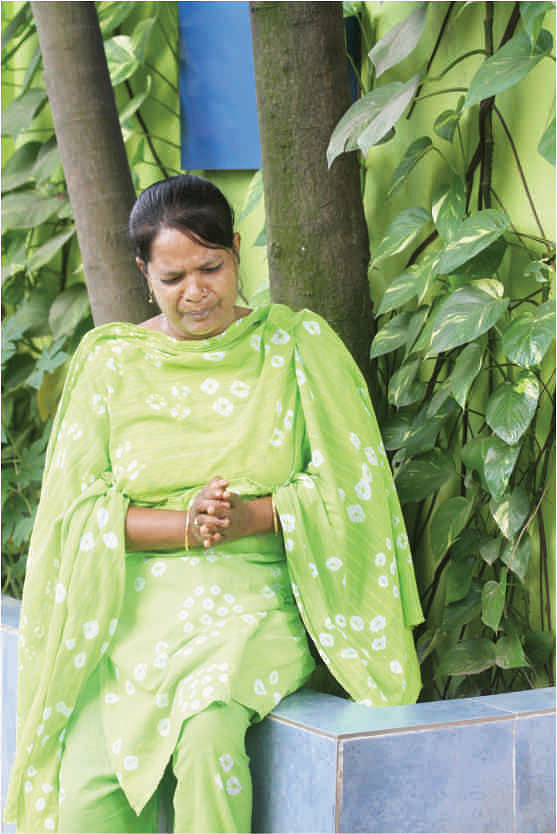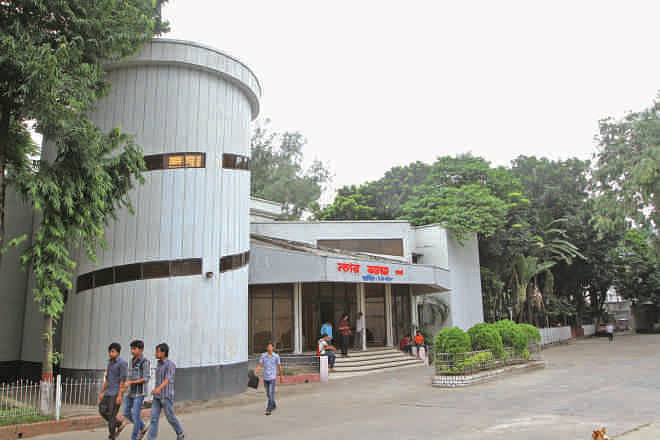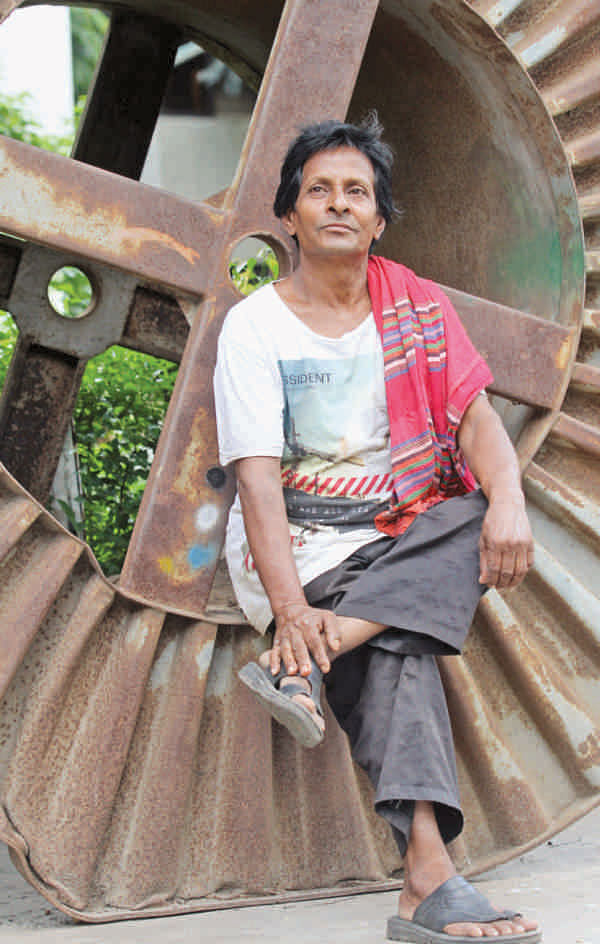Happily Ever After?

Newspapers and entertainment magazines are always trying to delve deep into the lives of film actors. No one pays any attention to those who devote their lives to making films a bit crispier for the audience. Once described as “extras”, they are now called junior artistes. This week the Star interviews some of the junior artistes of our film industry.
A group of young men wearing blue and khaki police uniform and ammunition belts are on the hunt for the notorious bandit Kali Sarder. They carry small guns on their waist and one of them has a battery operated walkie-talkie. The band of police is led by a young man, the hero of our story, who instructs the group as to how to go about doing their job. A dozen policemen are to surround the village so that no one can get out and they can carry out their search for Kalu with ease. Around 10 to 12 villagers gather under a banyan tree, in fear of their lives. Suddenly there is a burst of gunfire. Most of the policemen fall to the blood spattered soil. But the hero escapes the attack and attacks the villains on his own.
This scene has been played a number of times in several Bangla films. The hero is always the one single-handedly taking on the goons. He is the one who escapes a huge disaster without an injury. The hero -- the commercial profits of the film rests on whose shoulders -- gets much more scope, attention and space than the junior artistes. In fact, in the above mentioned scene, the junior artistes appear on the screen for a few minutes. But they carry the memory of these few minutes for the rest of their lives.
We enter the premises of the Bangladesh Film Development Corporation (BFDC) on a bright, sunny morning. You will find people gather around the Bangladesh Film Artists Association (BFAA) from as early as nine in the morning. They are here with the hope of getting a role, no matter how small, in the films. People from different age groups are called inside the office for an interview and later assigned to different shooting spots according to their specific talents. After working at the BFDC for many years, actors learn that even junior artists can impress the audience in their own charismatic ways, and thus, put in their best foot forward and try their best to get selected for a film.

Muhammed Sulaiman, in his eighties, has to wait in a line to get a small role in a film even years after working in the industry. When he realises that we are journalists, and are there to interview 'extras' about their lives and livelihood, Sulaiman corrects us, asserting with pride that they are “not extras but junior artistes.” On further prodding, he adds, “You cannot release a film with only the protagonists. Just like stars, we too are an important part of the film.”
Sulaiman has been working at the BFDC for the last 40 years and has witnessed many ups and downs in the film industry. At times, discouraged by the poor pay, he has thought about quitting, but in the end, he keeps going because of his deep attraction towards this art form. “I started acting when I was only fifteen. At that time I used to work for Jatra-Pala as a female artist.” He believes his voice still sounds like a woman's, “I first acted in Bhawal Sannyasir Pala', playing the role of queen Bibhabati, the second wife of Bhawal Sannyasi.” He grew such an attachment to the stage that he went on to do female roles for Jatra till his late thirties. The pay at Jatra pala was relatively poor, as Sulaiman was paid an average of Tk 2 to 3 for a day's work in the early fifties. Moreover, it was a seasonal job and performances were only held during the winter.
“There is no written employment contract for 'Jatra' and everything is fixed verbally.” That's the reason why in the sixties he decided to fulfill his passion by acting in films. “At that time, I would get Tk 10 for a shift of eight hours. Now we get a wage of Tk 1,000 for eight hours' work. But I am old now, and so I get fewer roles in movies,” he says.

Junior artistes working at the BFDC usually have another job apart from acting. Nasir, a middle aged junior artiste, has been working in BFDC for the last 25 years. Apart from acting, he sells tea at the shooting spot. “I came here when I was only 10 years old. At that time the space was not as developed as you see today. I lived in the Karwan Bazar slum and grew up there.”
Actor Ripon Shikdar was recently elected as a member of the Union Parishad from the Islampur union under the Shariatpur district. He has been in at least 250 action films. “Cinema is in my blood and for that reason I cannot leave it.” He has suffered several injuries during shooting “I was working on a film called Obhishopto Raat produced by Dipjol. The action director told me to jump from a three-storied building. I did and injured my left ankle very badly. I was hospitalised for 20 days.” Most junior artistes put in all their efforts to sustain in the industry, he says. “We work without any protection. I can assure you that no one in the world will be able to perform under such dire situations. We love the industry so we do not have the fear of death. Last week Jumman, a junior action artiste, got injured while running through a glass wall. We thought he would die, but thankfully, he survived, but he is still receiving treatment for his injuries.”
Interestingly, most junior artistes don't get the chance of seeing their films on the big screen. But they love to hear reviews about the movies they acted from the audience. On the day of the release of his films, Ripon goes to the theatre and waits outside for his friends. When they praise his work, Ripon feels as though he is on cloud nine. “It feels good when people like my work. I can't express in words the happiness I feel.”

While some junior artistes run small businesses for a living, Rowshanara has her own tailoring shop, equipped with four sewing machines and an assistant. Her husband died a long time ago and she now runs her family with the money she earns from acting along with the income generated by her tailoring shop. While talking to her, we are shocked to see her suddenly burst into tears. Within seconds she regains her composure. She informs us with a smile that she was only delivering her dialogue from the film 'Kokhono Megh, Kokhono Brishti' where she enacted the role of a beggar. “I can cry at will. The directors only need to give me my brief and I'll be able to carry it out. I have played an array of roles like that of a fighter, a vamp, beggar, a blind person, and so on,” says Rowshanara with a smile.

After its formation in 1984, the BFAA has been looking after the rights of artistes. It also helps the junior artistes to get roles in films. The Finance Secretary of BFAA Atiqur Rahman says that the organisation works hard to give it a professional character. “In the previous years, anyone could become a member of the BFAA but now we take interviews and the candidate must take an exam to become a member of the BFAA.”
Rahman believes that digitalisation can lead to the rebirth of the industry. He also says that 10 to 12 years ago, people from lower income brackets formed the major part of the audience. Thus, most films were produced keeping them in mind. “Profit hungry cinema hall owners and distributers would only seek out commercial films which had crude song and dance sequences and unnecessary action scenes. As a result, only a specific class of people went to the theatre. This pattern of operation was not profitable for those who considered films as their passion. Things, however, have changed over the years, and the current lot of artistes seems to be learning their lessons from their predecessors.”

Those who have good connections with the government bodies can easily get grants from the government to make films, alleges Ripon Shikder. “The young generation of actors and filmmakers should have better access in this regard. Most people blame the story and dialogues for the sorry state of affairs of the film industry. But apart from the story, there is also a scarcity of good junior artistes in Bangladesh. Some people are doing this job because they say their parents and grandparents did the same. They don't have any clue about acting, and they don't have any problems getting roles because they have the right connections. I believe that the situation needs to be changed in order for our films to change.”

During our visit we have made several attempts to speak to the female junior artistes at the BFDC. However, they have refused to share their experiences with us. Upon further investigation, we learnt that they are wary of journalists as they think they might be misquoted or negative things about them might be printed in the newspapers. One of the female junior artistes tells us on condition of anonymity that they have to suffer humiliation as many newspapers print false information about them or misquote them without even letting them know. She further adds that despite the pain and humiliation most female junior artistes prefer to stick to the industry for their love of films. She requests us to write positive things about them, urging us to motivate readers to go to the theatre to watch films. “The more people visit theaters to watch films, the more our earnings will increase. Besides, there is no greater joy than watching movies on the big screen,” she insists.

 For all latest news, follow The Daily Star's Google News channel.
For all latest news, follow The Daily Star's Google News channel. 



Comments